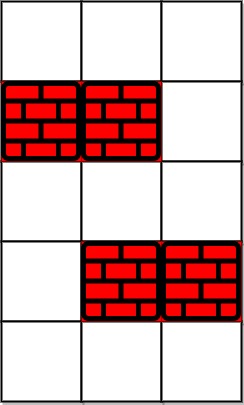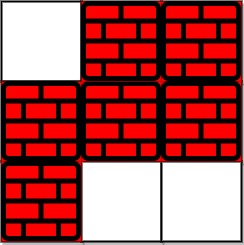1293. Shortest Path in a Grid with Obstacles Elimination
Question
You are given an m x n integer matrix grid where each cell is either 0 (empty) or 1 (obstacle). You can move up, down, left, or right from and to an empty cell in one step.
Return the minimum number of steps to walk from the upper left corner (0, 0) to the lower right corner (m - 1, n - 1) given that you can eliminate at most k obstacles. If it is not possible to find such walk return -1.
Example 1:

Input: grid = [[0,0,0],[1,1,0],[0,0,0],[0,1,1],[0,0,0]], k = 1
Output: 6
Explanation:
The shortest path without eliminating any obstacle is 10.
The shortest path with one obstacle elimination at position (3,2) is 6. Such path is (0,0) -> (0,1) -> (0,2) -> (1,2) -> (2,2) -> (3,2) -> (4,2).
Example 2:

Input: grid = [[0,1,1],[1,1,1],[1,0,0]], k = 1
Output: -1
Explanation: We need to eliminate at least two obstacles to find such a walk.
Constraints:
m == grid.lengthn == grid[i].length1 <= m, n <= 401 <= k <= m * ngrid[i][j]is either0or1.grid[0][0] == grid[m - 1][n - 1] == 0
Algorithm
Similar question to pervious one, leverage BFS in a grid to find a spot. Here the spot is the right bottom corner.
The tricky part is that here you can remove at most obstacle, so you will need keep this info when traversing.
Implementation
class Solution { public int shortestPath(int[][] grid, int k) { int[][] directions = new int[][] { {0, 1}, {0, -1}, {-1, 0}, {1, 0} }; int m = grid.length; int n = grid[0].length; Queue<int[]> queue = new LinkedList<>(); boolean[][][] visited = new boolean[m][n][k + 1]; queue.offer(new int[] {0, 0, k}); int steps = 0; while (!queue.isEmpty()) { int size = queue.size(); for (int i = 0; i < size; i++) { int[] node = queue.poll(); int row = node[0]; int col = node[1]; int left = node[2]; if (row == m - 1 && col == n - 1) { return steps; } for (int[] direction : directions) { int newRow = row + direction[0]; int newCol = col + direction[1]; if (newRow < m && newRow >= 0 && newCol < n && newCol >= 0) { if (grid[newRow][newCol] == 1) { if (left - 1 >= 0 && !visited[newRow][newCol][left-1]) { queue.offer(new int[]{newRow, newCol, left - 1}); visited[newRow][newCol][left-1] = true; } } else if (!visited[newRow][newCol][left]) { queue.offer(new int[]{newRow, newCol, left}); visited[newRow][newCol][left] = true; } } } } steps++; } return -1; } }